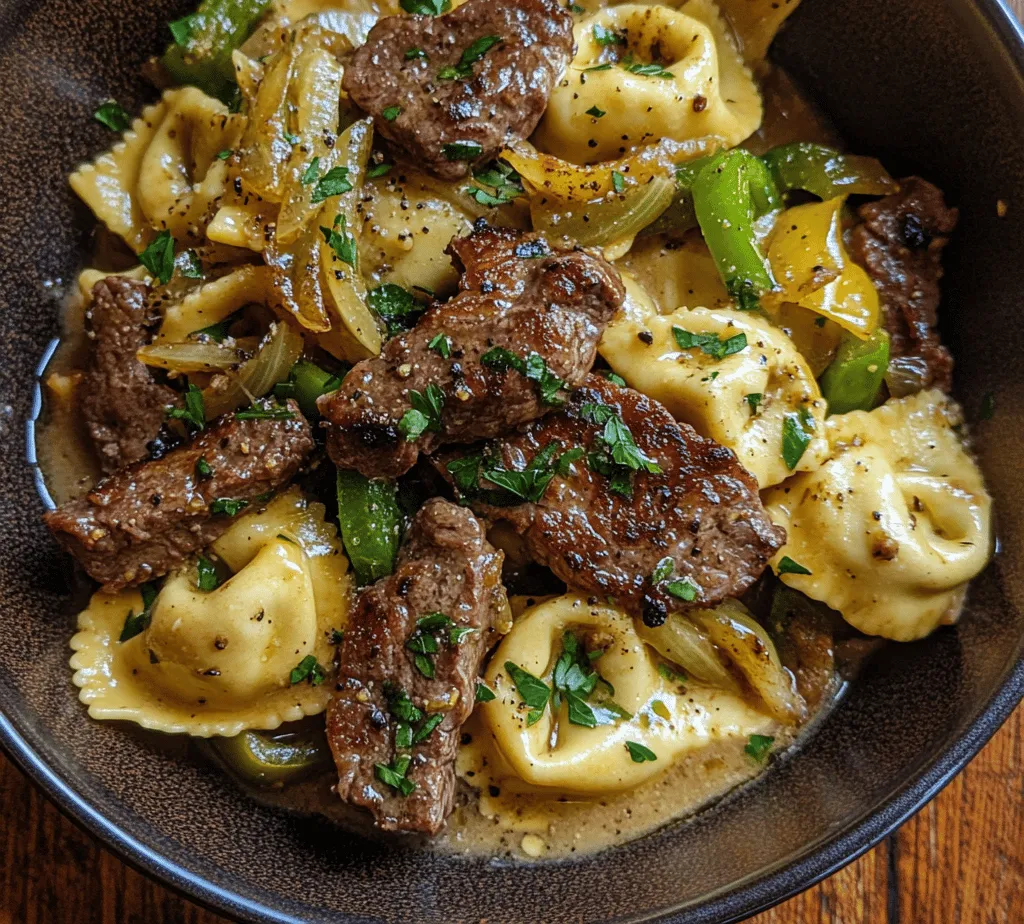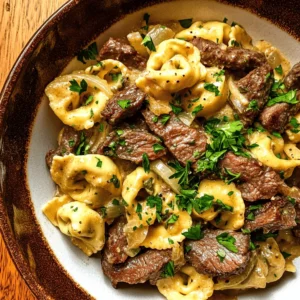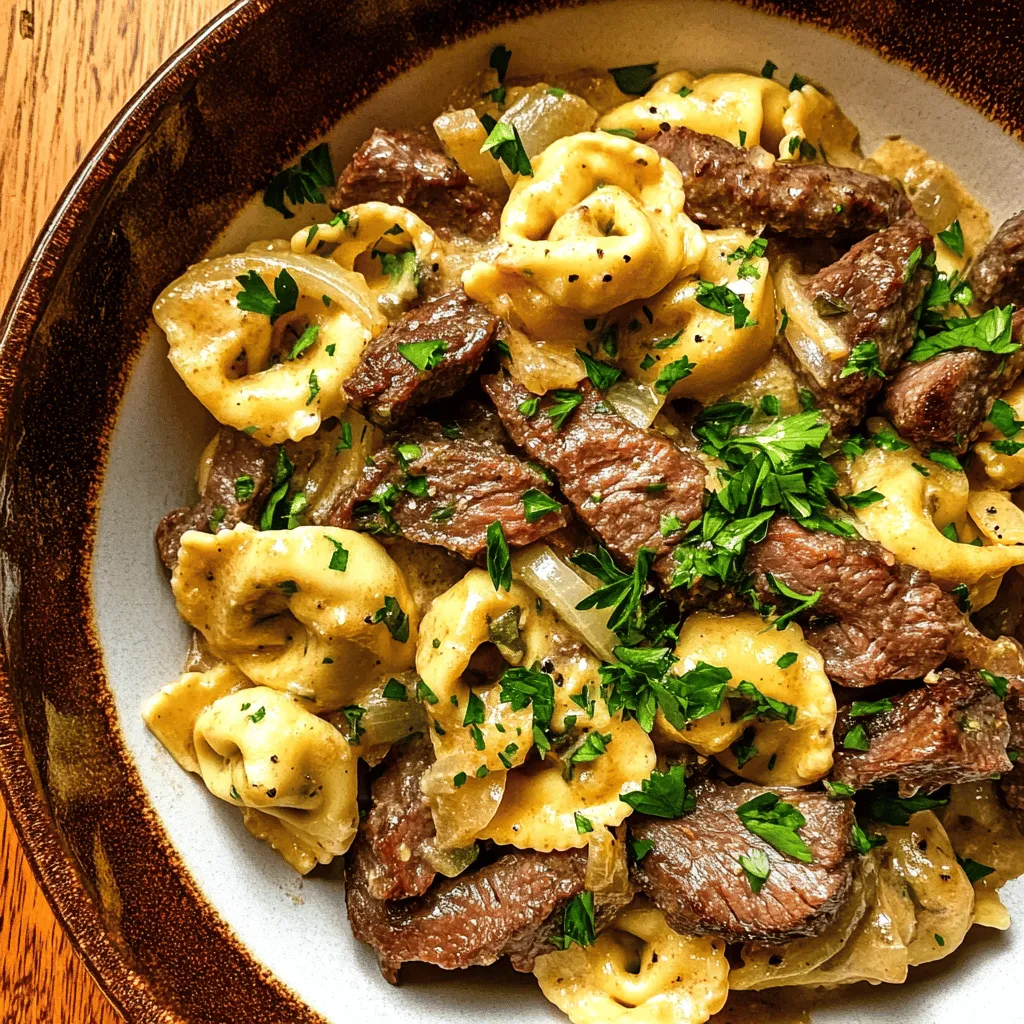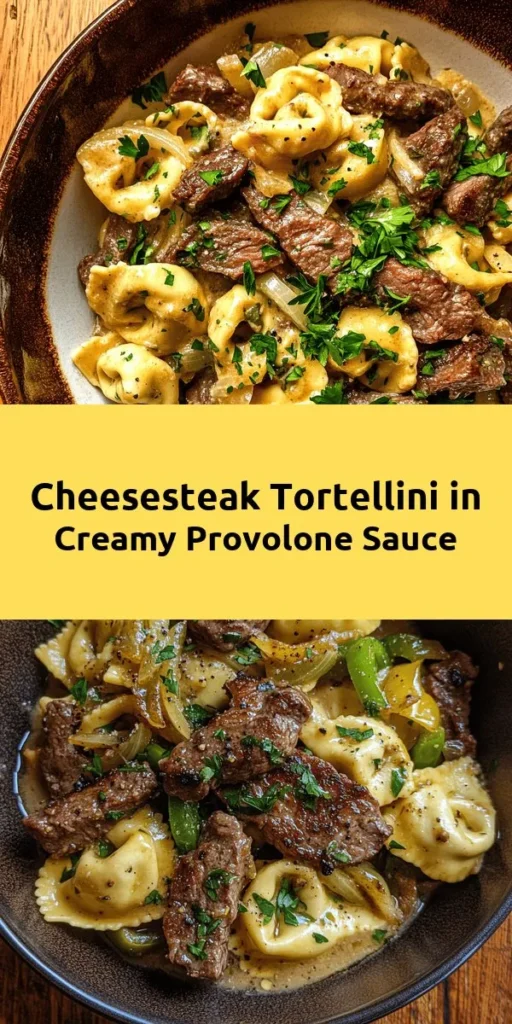In the world of comfort food, few dishes can rival the deliciousness of a cheesesteak. This iconic sandwich, loaded with thinly sliced beef, melted cheese, and sautéed vegetables, has won the hearts of food lovers across the globe. Now, imagine taking that beloved flavor and marrying it with tender cheese tortellini, all enveloped in a rich provolone sauce. This Cheesesteak Tortellini in Rich Provolone Sauce is a delightful fusion that brings together the best of both worlds. Perfect for busy weeknights or a cozy weekend dinner, this recipe is not only easy to prepare but also packed with flavor.
In this article, we’ll delve into the nuances of this dish, exploring its origins and providing detailed cooking instructions to help you recreate this culinary masterpiece in your own kitchen. Whether you’re a seasoned home cook or a beginner looking for an exciting recipe, this dish promises to impress.
Understanding the Basics of Cheesesteak Tortellini
Exploring the Origins of Cheesesteak
The classic cheesesteak traces its roots back to Philadelphia, where it was first created in the 1930s. Legend has it that Pat Olivieri, a hot dog vendor, decided to grille some beef on his cart one day. The aroma drew in customers, and soon, the cheesesteak was born. Over the decades, this simple yet satisfying sandwich has evolved, with various toppings and bread choices appearing, but the core ingredients remain the same: thinly sliced beef, cheese (often Cheez Whiz, provolone, or American), and sautéed onions.
As American cuisine has continued to evolve, pasta dishes have also gained popularity, with Italian influences becoming a staple in many households. The combination of these two beloved comfort foods—cheesesteak and pasta—has paved the way for innovative dishes like Cheesesteak Tortellini, allowing chefs and home cooks alike to experiment with flavors and textures.
Why Combine Cheesesteaks with Tortellini?
The fusion of cheesesteaks and tortellini offers an exciting culinary experience, blending two distinct flavors into one satisfying dish. The appeal of fusion cuisine lies in its ability to bring together different cultural elements, creating something entirely new and exciting. In this case, the rich, savory profile of a cheesesteak pairs beautifully with the soft, cheesy pockets of tortellini.
Moreover, tortellini enhances the cheesesteak experience by providing a unique texture and additional creaminess, especially when coated in a luxurious sauce. This combination not only satisfies hunger but also invites diners to enjoy a comforting and indulgent meal that feels both familiar and novel.
Ingredients Overview
To create the perfect Cheesesteak Tortellini in Rich Provolone Sauce, you’ll need to gather the essential ingredients that contribute to the dish’s rich flavor profile and comforting texture.
Key Components of the Dish
Cheese Tortellini: Fresh vs. Frozen
The star of this dish is undoubtedly the cheese tortellini. You can choose between fresh and frozen tortellini, both of which have their advantages. Fresh tortellini, often found in the refrigerated section of grocery stores, offers a delightful bite and a more nuanced flavor due to its fresh ingredients. However, if you’re looking for convenience, frozen tortellini is a great option—it’s readily available, has a long shelf life, and cooks quickly.
Regardless of your choice, it’s essential to cook the tortellini according to the package instructions to achieve that perfect al dente texture, which will hold up well in the rich sauce.
Choosing the Right Steak: Ribeye vs. Sirloin
When it comes to the steak for your cheesesteak tortellini, the cut you choose can make a significant difference in flavor and tenderness. Ribeye is a popular choice for cheesesteaks due to its marbling, which adds a rich, beefy flavor and ensures that the meat remains juicy as it cooks. On the other hand, sirloin is a leaner option that still provides a hearty taste without the extra fat. Both cuts can work well, so it ultimately depends on your preference and dietary considerations.
Essential Vegetables and Their Roles
The Importance of Onions and Bell Peppers
No cheesesteak is complete without the classic sautéed onions and bell peppers. These vegetables not only add flavor but also contribute to the overall texture of the dish. Onions become sweet and caramelized when sautéed, while bell peppers add a crunchy bite and vibrant color. Together, they create a delicious aromatic base that complements the beef and cheese beautifully.
Flavor Contributions of Garlic
Another essential ingredient in this dish is garlic. Its pungent aroma and rich flavor elevate the overall taste profile of the Cheesesteak Tortellini. When sautéed alongside the vegetables, garlic infuses the dish with a savory depth that balances the richness of the provolone sauce.
The Creamy Provolone Sauce
Understanding Provolone Cheese
Provolone cheese is a semi-hard Italian cheese that melts beautifully, making it an ideal choice for this dish. With a mild yet distinct flavor, provolone brings the cheesesteak essence to the forefront while complementing the tortellini. When melted, provolone creates a creamy, luscious sauce that envelops each bite of tortellini and steak.
The Role of Heavy Cream in Creating a Rich Texture
To achieve the desired creaminess in the provolone sauce, heavy cream is added. This ingredient not only enhances the richness of the sauce but also helps to create a velvety texture that clings to the tortellini and steak. The combination of provolone and heavy cream results in a sauce that is indulgent and satisfying, perfect for drenching your pasta and meat in flavor.
Step-by-Step Cooking Instructions
Now that we’ve explored the ingredients and their significance, it’s time to dive into the cooking process. Follow these detailed steps to ensure your Cheesesteak Tortellini in Rich Provolone Sauce turns out perfectly.
Preparing the Tortellini
1. Cook the Tortellini: Begin by bringing a large pot of salted water to a boil. Carefully add the cheese tortellini to the boiling water and cook according to the package instructions, usually around 3-5 minutes for fresh tortellini or 6-8 minutes for frozen. To achieve the ideal al dente texture, taste a piece a minute or two before the suggested cooking time is up.
2. Drain and Set Aside: Once the tortellini is cooked to perfection, drain it in a colander and set it aside. Avoid rinsing the tortellini, as you want to keep the starch on the surface, which will help the sauce cling better later.
Sautéing the Vegetables
1. Prepare the Ingredients: While the tortellini cooks, finely chop your onions, bell peppers, and garlic. Having everything prepped will streamline the cooking process.
2. Sauté the Onions and Peppers: In a large skillet or frying pan over medium heat, add a tablespoon of olive oil. Once the oil is hot, add the chopped onions and bell peppers. Sauté, stirring occasionally, for about 5-7 minutes or until the onions become translucent and the peppers soften.
3. Add the Garlic: Once the onions and peppers are perfectly sautéed, add the minced garlic to the pan. Cook for an additional 1-2 minutes until the garlic is fragrant, being careful not to let it burn, as burnt garlic can impart a bitter flavor.
4. Add the Steak: Increase the heat to medium-high and add your thinly sliced ribeye or sirloin to the skillet. Cook for about 4-6 minutes, stirring frequently, until the steak is browned and cooked through. Depending on the cut, you might want to adjust the cooking time to ensure the meat remains tender.
Following these initial steps sets the stage for a delicious Cheesesteak Tortellini in Rich Provolone Sauce. In the next part of this article, we’ll continue with how to make the creamy provolone sauce and combine all the elements to create this mouthwatering dish. Stay tuned!

Techniques for Achieving Perfect Sautéed Vegetables
Sautéing vegetables is an essential skill that enhances the overall flavor and texture of your Cheesesteak Tortellini in Rich Provolone Sauce. To achieve perfectly sautéed vegetables, follow these tips:
1. Choose the Right Vegetables: Bell peppers, onions, and mushrooms are traditional choices for a cheesesteak. Consider using a mix of colors for visual appeal and flavor depth. Red and yellow bell peppers add sweetness, while green bell peppers provide a slight bitterness that balances the dish.
2. Prep Properly: Cut your vegetables into uniform pieces to ensure even cooking. Thin slices work best, especially for onions and bell peppers, as they will cook quickly and meld seamlessly with the other ingredients.
3. Use High Heat: Preheat your skillet over medium-high heat. A hot pan will help to quickly sear the vegetables, giving them a nice caramelized exterior while keeping them tender inside.
4. Don’t Overcrowd the Pan: Cook in batches if necessary. Overcrowding can cause the vegetables to steam instead of sauté, resulting in a soggy texture.
5. Add Fat: Use a combination of olive oil and butter for the best flavor. The oil raises the smoke point, allowing you to cook at high heat without burning, while butter adds richness.
6. Season as You Go: Sprinkle a pinch of salt over the vegetables as they cook. This draws out moisture, enhancing their natural sweetness and flavor.
7. Finish with Fresh Herbs: A sprinkle of chopped fresh herbs, such as parsley or thyme, can elevate the flavor profile of your sautéed vegetables just before serving.
Cooking the Steak to Perfection
To complement your sautéed vegetables and ensure your cheesesteak tortellini is a hit, cooking the steak correctly is crucial.
1. Best Practices for Cooking Thinly Sliced Steak: Use flank or sirloin steak, as these cuts are flavorful and tender when cooked properly. Slice the steak against the grain into thin strips, about 1/8 inch thick. This technique helps break down the muscle fibers, resulting in a more tender bite.
2. Seasoning Tips for Optimal Flavor: A simple seasoning of salt, pepper, and garlic powder works wonders. For added depth, consider marinating the steak for 30 minutes in a mixture of soy sauce, Worcestershire sauce, and a touch of olive oil before cooking. This enhances the umami flavor and tenderizes the meat further.
3. Cooking Method: Heat a skillet over high heat and add a little oil. Once the oil is shimmering, add the steak in a single layer. Sear for 1-2 minutes without stirring to develop a nice crust. Flip and cook for another 1-2 minutes. Be careful not to overcook; the steak should be medium-rare to medium for the best texture.
4. Resting the Steak: Once cooked, allow the steak to rest for 5 minutes. This helps redistribute the juices, ensuring each bite is flavorful and juicy.
Creating the Provolone Sauce
A rich provolone sauce is the star of your dish, offering a creamy, cheesy element that binds all flavors together.
1. Steps to Ensure a Smooth and Creamy Sauce: Start by melting butter in a saucepan over medium heat. Once melted, add an equal amount of flour to create a roux. Cook for about 2 minutes, stirring constantly to eliminate the raw flour taste. Gradually whisk in milk or cream, ensuring there are no lumps.
2. Adding the Provolone: Once the mixture is smooth and thickened, reduce the heat to low and gradually add grated provolone cheese, stirring continuously until melted and creamy. If you can’t find provolone, a blend of mozzarella and parmesan can work as a substitute.
3. Adjusting Consistency and Flavor: If the sauce is too thick, thin it with a splash of milk until you reach your desired consistency. For extra flavor, consider adding a dash of hot sauce, a pinch of nutmeg, or even a tablespoon of Dijon mustard for depth.
Bringing It All Together
Now that you have your sautéed vegetables, perfectly cooked steak, and luscious provolone sauce, it’s time to bring everything together.
1. Combining Tortellini with the Sauce and Steak: In a large pot, cook the tortellini according to package instructions until al dente. Drain and return to the pot. Add the sautéed vegetables and cooked steak, then pour the provolone sauce over the top. Gently toss to combine, ensuring the tortellini is evenly coated.
2. Final Heating Tips for the Perfect Serving Temperature: If the mixture has cooled, place the pot back on low heat, stirring gently until everything is warmed through. Be cautious not to overheat, as this can cause the cheese to become grainy.
Serving Suggestions
Creating an inviting presentation enhances the overall dining experience.
Plating the Dish for Maximum Appeal
1. Garnishing with Fresh Parsley: Transfer the Cheesesteak Tortellini to a serving platter or individual bowls. Finish with a sprinkle of freshly chopped parsley for a pop of color and freshness. Consider adding a sprinkle of freshly cracked black pepper for added visual appeal.
2. Recommended Side Dishes for a Complete Meal: To complement the richness of the dish, serve with a light side salad dressed in a vinaigrette or garlic bread to soak up any extra sauce. Roasted vegetables or steamed broccoli can also balance the meal with a healthy touch.
Pairing with Beverages
1. Wine Pairings that Complement the Richness of the Dish: A medium-bodied red wine such as Cabernet Sauvignon or a Malbec pairs beautifully with the savory steak and creamy sauce. The wine’s tannins will cut through the richness, providing a well-rounded dining experience.
2. Non-Alcoholic Options for a Family-Friendly Meal: For a family-friendly alternative, consider serving sparkling water with a splash of lemon or a homemade iced tea. These options are refreshing and won’t overpower the flavors of the dish.
Nutritional Information
Understanding the nutritional profile of your Cheesesteak Tortellini is beneficial for health-conscious diners.
1. Caloric Breakdown of the Dish: On average, a serving of Cheesesteak Tortellini in Rich Provolone Sauce contains around 600-700 calories, depending on the portion size and specific ingredients used. This includes the tortellini, steak, sauce, and vegetables.
2. Understanding the Nutritional Value of Each Ingredient: The dish is rich in protein from the steak and cheese and provides carbohydrates from the tortellini. Adding vegetables boosts fiber and micronutrient content, making it a more balanced meal.
3. Tips for Modifying the Recipe for Dietary Needs: To make the dish lighter, consider using whole wheat tortellini or reducing the amount of cheese in the sauce. For a vegetarian option, replace the steak with sautéed mushrooms or a plant-based protein alternative.
Conclusion
Cheesesteak Tortellini in Rich Provolone Sauce is more than just a meal; it’s an experience that brings together the beloved flavors of a classic dish in a fresh and exciting way. This recipe is simple enough for any home cook to master, yet indulgent enough to impress family and friends. With its creamy texture, savory steak, and delightful tortellini, this dish is sure to become a staple in your culinary repertoire. Enjoy every bite, knowing you’ve crafted a delicious fusion that captures the essence of comfort food at its finest.



